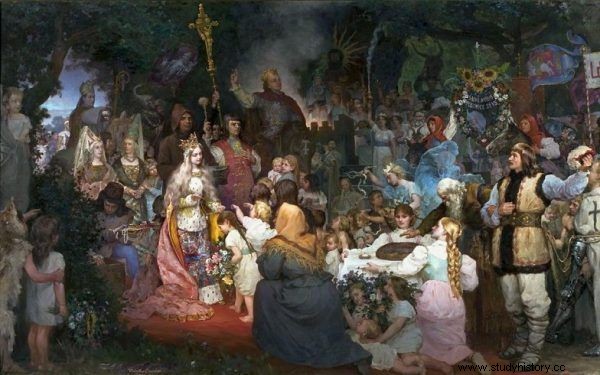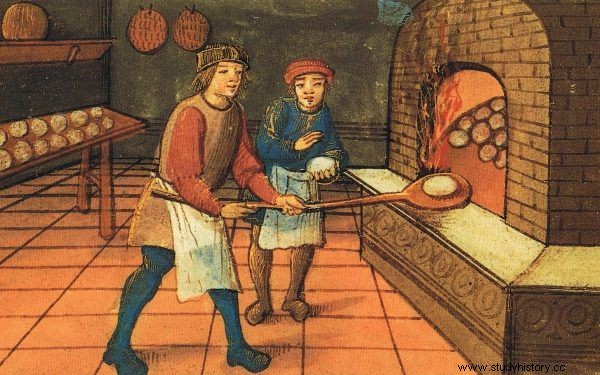Hundreds of sophisticated dishes on the tables, two bands, delicious beers and wines. At the court of Jadwiga and Jagiełło, people knew what a successful party should look like!
The most popular medieval amusements may have been simple. The male part of the population liked to have fun at the inn, drink alcohol and play cards or dice. The women enjoyed the most folk fun and dancing. They were arranged everywhere:not only in taverns, but also in monastery refectories, and even in church cemeteries. Especially the latter must have aroused opposition from the clergy!
Various public events were an additional entertainment:ceremonies with the participation of the ruler, coronations, performances of famous preachers, processions, relics transfer, funerals of famous personalities, public executions ... But it had little to do with the entertainment of the then elites.
Dancing queen
Jadwiga was used to high-quality entertainment from an early age. She grew up in an elegant 350-room castle in Buda, where court life flourished. Knight tournaments and court games were organized. There was no shortage of musicians and artists, and when someone was looking for a quieter entertainment, you could take advantage of a large book collection. Care was also taken to dress in line with the trends.
Thanks to this environment, Jadwiga herself read a lot, appreciated music and the art of conversation. But also, as Anna Klubówna wrote, she liked games, dances, representative feasts, costumes, jewels and furs . And she brought these passions with her to Krakow. She passed them on to manors, both noble and daughters of wealthy Krakow burghers.

Even as a girl, Jadwiga was a fashion icon and trendsetter in Poland. In this painting by Władysław Ciesielski, depicting the baptism of Lithuania, we can clearly see its distinctive garb (source:public domain).
Archduke Wilhelm Habsburg wanted to use the queen's passion for dance. The would-be spouse of Jadwiga wanted to become the king of Poland very much and when he came to Krakow in the summer of 1385, he began to organize dances for her. Perhaps he wanted to erase the bad impression in this way from the symbolic planks, arranged after their "wedding" (eventually incomplete) in 1378. The then 6-year-old Austrian did not show off before the 4-year-old Hungarian, because ... marriage!
Jadwiga actually had to forget this incident, since after many years in Krakow she was persuaded to dance together for two weeks. But nothing else happened:the queen was always accompanied by courtiers and knights. Jan Długosz described these meetings as follows:
Queen Jadwiga repeatedly descended from the castle in the retinue of knights and her girls to the convent of St. Francis in Kraków and in the refectory of that monastery, he consoled himself by dancing with the aforementioned Austrian prince William, but very modestly and with the greatest moderation.
Eventually William had to acknowledge his defeat and left.
Common passions of Jagiełło people
When Władysław Jagiełło finally became the spouse of Jadwiga, it seemed that it would be difficult for the newlyweds to find common entertainment. Fortunately, contrary to the "polite" information sent to Krakow by the Teutonic Knights, he did not turn out to be a shaggy savage, a lewd pagan, and even less a cannibal. However, he had a slightly different - definitely simpler - idea of relaxation, fun and rest than Jadwiga.
He eagerly hunted, ate pears and listened to the singing of nightingales. And whenever he had the opportunity, he also liked to sleep and spend the holidays until noon . Therefore, moreover, the Holy Mass. he rarely listened at the right time , as Jan Długosz pointed out to him, who did not like the king and did not avoid petty malice.
However, the spouses were united by a passion for hunting and music. The queen rode a horse, she had her own shooters, falconers and dog breeders. There were also two bands at Wawel! Jagiełło and Jadwiga maintained their own separate ensembles consisting of trumpeters, flute players and drummers. Additionally, the king had wanderers, and the queen had a citristy from Handslik. Sometimes she also listened to the performances of young, promising artists. It is even possible that the Wawel Castle was visited by itinerant singers telling stories about distant countries and brave knights ...

Jadwiga, like her husband, was a lover of hunting and music. The illustration of Jadwiga by Aleksander Augustynowicz (source:public domain).
Feasts… whatever the occasion
However, the highest form of entertainment for the high-born was undoubtedly the court feasts. The ruler did not refuse to participate in them. And there were many occasions! The pretext for having fun were, for example, the visits of the king's sister, Duchess Aleksandra, the wife of Duke Siemowit IV of Mazovia.
Christmas was also sumptuously celebrated. The celebrations did not last as today, until December 26. On the contrary! This day was just the beginning of the so-called mating, or twelve generous days . Celebrations until Epiphany.
We do not know exactly what the celebrations looked like. We can guess, however, that those who could afford it enjoyed themselves to the full:they ate, drank, and listened to music. They watched nativity plays, and maybe other theatrical plays, of course of a religious nature. Carols were probably already sung at that time. On the other hand, there was no standing Christmas tree with ornaments and candles, nor the custom of celebrating New Year's Eve.

If the party is at Jadwiga and Jagiełło's, it's only with tables bending with food. A miniature from the 16th century chronicle, depicting the wedding of this couple (source:public domain).
Royal Cuisine Specials
Special occasions called for special preparations. When guests came to Wawel, the number of dishes increased to forty or fifty. When they were visitors, the hosts cared for in particular, it could even be a hundred! The revelers did not spare their food, they also had to show a real appetite. On average, each of them ate 2 kg of meat! The hosts ate even more:the king and queen received two capons each ...
The choice of dishes was really huge. On the tables were brought, among others baked, boiled or smoked meats. There was pork, beef, veal, poultry and game. Some of the dishes were served in a very elaborate way, such as peacocks with tail feathers.
There were also a lot of fish:both river and specially imported, such as herring or extremely expensive salmon. Next to them were crayfish, as well as dairy products and vegetables. They were accompanied by bread (only wheat!) And groats, which could - in a luxurious version - replace rice imported from overseas.
For dessert, there were fresh or dried fruit and poured with honey, as well as cheese dumplings, croissants, biscuits and cakes. Gingerbread was a novelty (other dishes also had spices). People were treated with spice and sugar pills gilded on the outside . However, this specialty was quite expensive, so sometimes a slightly cheaper option was chosen:equally tasty jam.

Bread for the king's table? Only whites, wheat! The picture shows medieval bakers at work (source:public domain).
The problem with this abundant feast was ... cutlery! At that time, there was not such a rich choice of them as it is today. Tips on how to deal with this could be found in the rhyming guide of medieval savoir-vivre by Przecław Słota from Gosławice. For example, the author advised that you should… wash your hands first.
It was not proper to rummage in the bowl:food had to be selected with two fingers from the top. A portion should be given first to the lady sitting next to you, before you put yourself together. It was also good tone to eat and talk alternately, not to spit out the chewed food and not to dip your nose in the beer foam.
Water? For washing only!
It was the beer that reigned supreme on medieval tables. At that time, however, it was not only seen as an alcoholic drink. Beer, made from barley, millet or wheat with the addition of hops, was a universal drink. It is even indicated by its name, derived from the word "drink". So, women and children drank beer as well as men. Only some people could get drunk. This is how the historian of Polish culture, professor Aleksander Brückner wrote about this drink:
Water was used for washing, not for drinking; people got used to water and got sick from it (...) Beer was drunk all day to cool down or to thirst, just like we drink water.

Thanks to Kamil Janicki's book entitled "Ladies of the Polish Empire" you will learn the history of women who built a superpower.
Interestingly, King Władysław did not share the reluctance to drink water. Apparently, he only drank water! Caution and suspicion caused him:the spring water was the hardest thing to poison unnoticed. For the same reason, his utensils and knife could only be touched by one trusted courtier.
On the other hand, the safety of fellow diners was taken care of by ... a plant! On the royal table there was a golden vessel filled with dragon tongues, that is, leaves and stalks of the tonguefish. Supposedly, they had mysterious wound-healing properties and, placed on the table, protected the feasters from poison. Unfortunately, it is not known how…
So what was drunk at feasts to get drunk? Rather than beer, people chose meads or wines. The former were most often made of dark and buckwheat honeys. They were produced by Capuchins, Bernardines or masters associated with the guild of mead makers.
On the other hand, white and red wines were imported from abroad, mainly from France and Italy. It was probably not a cheap pleasure, since Brückner mentioned that wines in the fourteenth and fifteenth centuries [were] completely unknown, neither at the royal table, perhaps exceptionally . However, there have already been advice on how to administer them. According to them, you should drink more wine in October, keep sweet in November, and serve cinnamon in December. But January was the month when it was good to drink the most.

Have they eaten? So it's time to drink! This was done by Jadwiga's great cousin, King Casimir III the Great, at a feast at Wierzynek's. A painting by Bronisław Abramowicz from 1876 (source:public domain).
And what about Hungarian wines, which the queen raised in Buda should like? Famous liquors appeared in Poland only after it, in the 15th century, Tokaje later still, because only with the next Hungarian monarch, Stefan Batory. However, they quickly became one of the most popular Magyar goods in Poland. The Polish nobility willingly spent the gold earned on the sale of grain on them! Tokay was also liked at other royal courts in other countries, and King Louis XIV called tokay "the king of wines and the wine of kings".
Queen Jadwiga would probably be proud of the Poles' love for the fruits of the work of her native country. If she could predict the future, perhaps she would have devoted a small toast to it at one of her - literally and figuratively - royal feasts!
***
You can read more about Queen Jadwiga in Kmil Janicki's book We will give the Polish empire .
